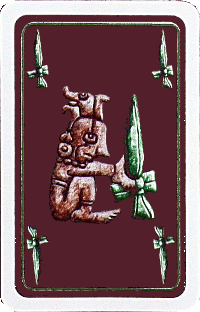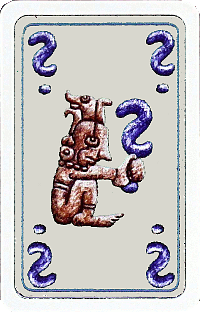Yucata
In the deepest rain forests of Mexico, near the town of Palenque, stands the
Mayan Sun temple. Here in 1995, the famous archaeologist and games expert
Stefan Dorra, discovered the remains of an ancient game. He used these to
reconstruct the game, probably last played around 1300 A.D. The spaces on the
board of Yucata' exactly match the ground plan of this renowned archaeological
site. The pale and dark stones in the game represent good and evil influences,
which the players seek to collect, or avoid. Probably Yucata' was played solely
by Mayan priests, as part of their ancient rituals, but there aren't many Mayan
priests around these days, so it's probably safe enough to play the game,
without any risk of angering the Gods.
Preparation
Each player receives an amulet and 7 cards in the matching colour. The cards are
held in the hand, the amulet placed on the first space of the board (The large
space in one corner).
Course of Play
First choose a starting player. Starting with this player and continuing in a
clockwise direction, each player plays one of their cards and moves their
amulet the corresponding distance. This process continues until an amulet
reaches or passes the end space. More than one amulet may stand on any space.
The Cards


-
Playing a 1,2,3,4, or 5 card moves the amulet 1,2,3,4, or 5 spaces forward
around the board.
-
If a player plays the
 -card,
they must move their amulet to the space in front of the leading amulet.
If the player with the leading amulet plays it, they move their amulet one
space forwards.
-card,
they must move their amulet to the space in front of the leading amulet.
If the player with the leading amulet plays it, they move their amulet one
space forwards.
-
If a player plays the
 -card,
they move their amulet in exactly the same way as the previous player, i.e. if the previous player played a 4 card, then the question mark
card would act as if it were a 4 card etc. That means that card copies the card last played.
-card,
they move their amulet in exactly the same way as the previous player, i.e. if the previous player played a 4 card, then the question mark
card would act as if it were a 4 card etc. That means that card copies the card last played.
-
The
 -card
may not be played as first card.
-card
may not be played as first card.
-
A player may only play the same card as the previous player if it is their last
card. As long as they have a choice, they must play a different card from that
played by the previous player.
-
Cards played are placed face up on the table in front of the player. Subsequent
cards are placed on top of the first card. In this way all players can see
which card each player played last. Once all 7 cards have been played, the
players pick their cards back up and play on with the full set again.
The Stones
If an amulet reaches or passes a space with a stone on it the player must take
this stone. If for example the leading amulet is moved three spaces, the player
will have to take three stones. There are never any stones on the board behind
the leading amulet.
Game End
Movement ends as soon as all 35 stones have been taken. Then the scores are
worked out. First, the player who has taken the red stone returns it to the
box, along with one dark blue stone. If the player doesn't have any blue
stones, the red stone has no function. Each player must now return pale stones
to the box, depending on how many dark stones they have.
1 Dark stone, return one pale stone
2 Dark stones, return 3 (1+2) pale stones
3 dark stones, return 6 (1+2+3) pale stones
4 dark stones, return 10 (1+2+3+4) pale stones
and so on
The player who has the most pale stones left after this is the winner.
Alternative layouts
The layout of the stones on the board can be altered to give a new dimension to
the game of Yucata'. The layout given on the board is only one of many
possibilities. A selection of ceremonial Mayan arrangements is given here:
Ceremonial layouts from Mayan history
Kintaya (Evil traps) The master of this ceremony (i.e. the
winner of this game), was recognised as a skilful leader, capable of avoiding
the most subtle traps (intrigues). They were accorded particular respect in
Mayan society.
Monzola (Sweet figs) The fig was for the Mayas, a symbol of
temptation. Those who succumbed, had to reckon with uncomfortable consequences.
Only a player who managed to resist temptation had a chance of winning and so
of rising to the priesthood.
Ayuno (Major leap) or Mayaya (Twins)
This was
a ceremony to decide on elevation to the priesthood. A candidate for the
priesthood needed to complete both the Ayunito and the Ayuna ceremonies with
distinction if they were to be accepted. In this way the Mayans tested the
power and foresight of the candidates. Any candidate who failed the tests was
permitted to repeat them as often as they wished.
Ayunito (Minor leap) This layout, along with the "Ayuno"
ceremony, were the two most important tests for any candidate for the Mayan
priesthood..
Tumo Zumo (Great caution) This game can only be won by a player
who plays with the outmost caution throughout, without being too defensive.
This ceremony was therefore used to find the best military commanders.
Zattopusta (Stormy wind) The wind blows hard, and then dies
away. The winner of this game was considered worthy to join the council of the
Wise.
Acuma y Taya (Water and light) The arrangement of the dark
stones, suggests the "Taya", the rainbow symbol. The winner of this game was
considered to be the favourite of the rain god, and so suitable to lead the
water ceremonies.
Ozzi Krakra (7 black ravens)The ravens symbolise famine, and
may have been a reminder of 7 years of drought at some time in the past. The
winner of this game was considered worthy of the honour of carrying out the
annual fertility ceremony.
Yazurika This is a random board layout.